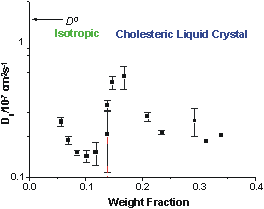Paul Russo

Emeritus Professor - Polymers & Colloids -- Roy Paul Daniels Professor
Bachelor's Degree(s): University of Wisconsin - River Falls, 1976
PhD: University of Minnesota, 1981
PostDoc: University of Massachusetts, 1981-83
Phone: (225) 578-5729
Fax: (225) 578-3458
E-mail: chruss@lsu.edu
Office: 242 Choppin Hall
Area of Interest
This group studies polymeric and colloidal fluids and materials made from them. In the same laboratory and on the same day, a student may isolate tobacco mosaic virus, an excellent model system for macromolecular dynamics, from our own greenhouse plants, while another student helps industrial visitors obtain a polyethylene molecular weight distribution. The unifying theme is “large stuff": polymers, biopolymers or colloidal particles and even polycolloids.
Students of this group become generalists, familiar with several methods of science on the nanometer scale. They must also become highly skilled specialists in one or two techniques. In-house specialties include laser light scattering, multidetector gel permeation chromatography, analytical ultracentrifugation, and our own, very highly developed fluorescence photobleaching recovery instrument. We will soon co develop small angle X-ray scattering, one of the most important methods of materials science, at LSU’s dedicated synchrotron light source. We also use other facilities around the campus: rheology, thermal characterization, electron microscopy and DOSY NMR. Every student performs some synthesis, ranging from simple (attaching a fluorescent dye) to hierarchical synthesis of core-shell polymer colloid composites and colloidal superstructures.
OK, so what are our projects?
Dynamics of rodlike polymers in complex fluids. We are studying the diffusion of rodlike polymers in gels, liquid crystals and entangled solutions. That’s important because rodlike polymers, among the strongest organic materials known, are often processed into useful devices from these complex fluids. We must learn how quickly they would dissolve or phase separate. The figure below is the first of its kind anywhere. It shows that diffusion of a rodlike polymer increases with concentration as the rods enter into a liquid crystalline phase. Funded by NSF continuously since 1986, this project is now turning towards mixtures of rods and flexible polymers, which are the precursors of rod/coil composite materials. This will also entail rotational diffusion measurements.

Polymer-silica composite particles. We make core-shell particles with a SiO2 interior and chiral, homopolypeptide exterior. A typical size would be 200 nm. The helix-coil transition available to the shell promises to make these “smart” colloids—able to respond to external stimuli. We are very excited about their self-assembly into colloidal crystalline arrays. The resulting light diffraction produces the brilliant colors shown. Absorption spectra reveal excellent color purity. Current work focuses on making linear assemblies of the particles. Funded by the American Chemical Society.
Characterization of amyloid plaques. With professors Hammer, McLaughlin and McCarley, we are studying the physical self-assembly of peptides derived from amyloid precursor protein, which have been implicated in Alzheimer’s disease. We measure the rate of the self-assembly, the stability of the aggregates, and how these properties change upon addition of “blocker” peptides synthesized by other team members. Funded by NIH (Prof. Hammer, main investigator).
Improved polymer characterization. Properties that are simple for small molecules, such as molecular weight, are harder to determine for polymers. With industrial support, we are simplifying light scattering and fluorescence photobleaching recovery for wider applications.
Off-campus Collaborations. Our unique combination of methods draws a variety of collaborators. With support from the National Textiles Center in North Carolina, we apply fluorescence photobleaching recovery to measure the very slow diffusion of dyes in fibers. This will require development of improved optical methods. With support from the U.S. Department of Agriculture through the University of Southern Mississippi, we study the effect of an environ-mentally safe pesticide (derived from a naturally occurring bacterium) on lipid bilayers. With a collaborator from McMaster University in Canada, we use similar methods to study the effect of pH on human influenza, a complex of proteins, lipids and nucleic acids.
Integrative Graduate Education and Research Training. We are heavily involved in the NSF-IGERT project, “Teaching Craft for Macromolecular Creativity.” IGERT supports new, team-based research projects, while providing special opportunities for its student participants. What would you like to do?
Awards & Honors
NSF Creativity Award, 2004
Dow Chemical Analytical Scientist's Teamwork Award, 2002
Selected Publications
Please see https://sites01.lsu.edu/wp/msg/emeritus-members/ to view our publications.
Former Ph.D. Students
Zimei Bu, PhD,08/94, Fox Chase Cancer Center
Garrett Doucet, Ph.D.,01/04, Research Scientist
Randall Cush, Ph.D.,01/02, Syngenta Crop Protection, Inc.
L. DeLong, PhD, Union Carbide
Mazidah Mustafa, PhD, Mother of 2
Debbie Tipton, PhD, Phillips Petroleum
Daewon Sohn, PhD, Professor, Han Yang University
Keunok Yu, PhD, Kunsan National University
Lucille Smith-Wright, PhD, U.S. Geological Service